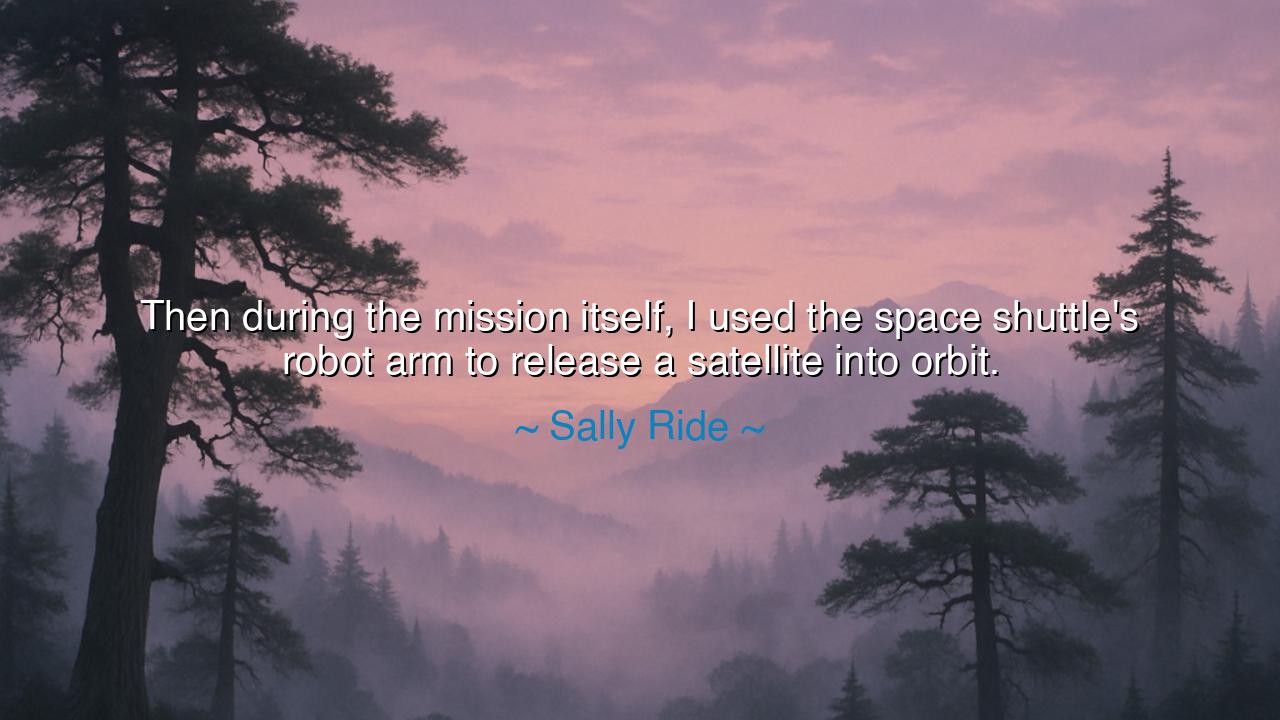
Then during the mission itself, I used the space shuttle's robot
Then during the mission itself, I used the space shuttle's robot arm to release a satellite into orbit.






Hear now the words of Sally Ride, the first American woman to pierce the heavens: “Then during the mission itself, I used the space shuttle’s robot arm to release a satellite into orbit.” At first, they seem plain, spoken with the modesty of a scientist recounting her work. Yet to those with ears to hear, they ring with the thunder of history. For these words mark not only the act of releasing a satellite, but the dawn of a new era in which humankind, aided by the tools of its own creation, began to stretch its hand into the infinite.
The space shuttle, like a chariot of fire, was itself a marvel of human ingenuity. But within its frame rested the robot arm, a mechanical limb born of earth yet strong enough to guide a child of metal into the celestial sea. And there was Sally Ride, not merely a passenger, but the one who guided this arm with precision and courage, casting forth a satellite to join the silent dance of stars. In that act, humanity proved that it was not only a watcher of the heavens, but a craftsman of their order, shaping the sky with tools of its own making.
Consider, children of time, what it means to release a satellite into orbit. It is not merely to fling an object into the void; it is to bestow upon it a place in the eternal rhythm of the cosmos. The satellite, once bound to earth, now circles forever in freedom, carrying messages, wisdom, and light to distant lands below. So too does every great act of courage: it sets loose something greater than itself, a force that continues long after the hand that launched it has withdrawn.
History remembers Sally Ride not only for her achievement but for what she embodied. In 1983, she became the first American woman in space, breaking barriers of doubt and prejudice. Many had said space was a realm for men, that the heavens were not yet open to all. But when Ride guided the robot arm with steadiness, she was not only releasing a satellite—she was releasing the spirit of possibility for women across the world. Her mission was not only for science, but for the dignity of half of humankind.
Reflect also on the humility of her words. Where others might boast of conquest, Ride spoke simply, as though describing an ordinary task. Yet herein lies the wisdom: greatness does not cry out its name. The truest pioneers see their deeds not as monuments, but as duties. They know that the value of their work lies not in glory, but in the service it renders to others. A satellite in orbit does not proclaim itself, but it transforms the world below.
What then shall we learn from her? That each of us holds a robot arm of our own—some tool, some gift, some power by which we can release something into the world. It may not be a satellite of steel, but a word of kindness, a labor of justice, a spark of imagination. Once set free, these too take orbit, circling among men and women, carrying unseen blessings that outlast the moment of their release.
Therefore, O seekers of wisdom, do not withhold the gifts placed in your hands. Dare to use them, as Sally Ride used hers, with steady courage and quiet strength. For the act that seems small to you may, in the course of time, circle the earth and touch countless lives. Learn from the astronaut: to build, to release, and to trust that what you set forth with noble purpose will find its place among the stars.
And so let this be the lesson carried through the ages: your life is a mission, and your deeds are the satellites you set into orbit. Choose well what you release, for it may circle in eternity long after you have passed. In this, you join the great chain of pioneers, lifting your hand as Ride lifted hers, and shaping the heavens with the courage of your heart.






AAdministratorAdministrator
Welcome, honored guests. Please leave a comment, we will respond soon